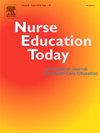Comparison of standardized patient and medium-fidelity simulation practices on nursing students' knowledge, staging, and satisfaction regarding pressure injuries: A randomized controlled trial
IF 3.6
2区 医学
Q1 EDUCATION, SCIENTIFIC DISCIPLINES
引用次数: 0
Abstract
Objectives
This study aimed to compare the effects of education using standardized patients (SP) and medium-fidelity simulation (MFS) on nursing students' knowledge, staging, and satisfaction related to pressure injuries (PI).
Design
A pre- and post-test, double-blind, randomized controlled trial.
Methods
The study included nursing students (n = 79) from a nursing faculty in western Turkey between April and July. Data were collected using the Student Characteristics Form, the Pressure Ulcer Knowledge Assessment Tool 2.0 (PUKAT 2.0-T), the Pressure Injury Staging Form, and the Student Satisfaction and Confidence in Learning Scale.
Results
The SP (n = 40) and MFS (n = 39) groups did not demonstrate any significant differences in staging levels (SP: 9.42 ± 3.24, MFS: 10.41 ± 2.96) or PI knowledge (SP: 11.73 ± 3.39, MFS: 12.00 ± 4.52) following the simulation experience. Both groups showed a statistically significant increase in PI knowledge and staging levels after the interventions compared to before (p < .05). The learning satisfaction level of the SP group (23.03 ± 2.37) was significantly higher than that of the MFS group (21.51 ± 4.03) (p < .05). No significant differences were found between the groups regarding self-confidence levels (p > .05).
Conclusion
Both simulation methods improved students' PI knowledge and staging levels; however, the satisfaction level of students in the SP group was found to be higher. Therefore, it is recommended to enhance the realism of PI education using SPs and to expand the use of simulation practices.
Registration
The study has been registered with the National Library of Medicine Clinical Trials: NCT05946291.
求助全文
约1分钟内获得全文
求助全文
来源期刊

Nurse Education Today
医学-护理
CiteScore
6.90
自引率
12.80%
发文量
349
审稿时长
58 days
期刊介绍:
Nurse Education Today is the leading international journal providing a forum for the publication of high quality original research, review and debate in the discussion of nursing, midwifery and interprofessional health care education, publishing papers which contribute to the advancement of educational theory and pedagogy that support the evidence-based practice for educationalists worldwide. The journal stimulates and values critical scholarly debate on issues that have strategic relevance for leaders of health care education.
The journal publishes the highest quality scholarly contributions reflecting the diversity of people, health and education systems worldwide, by publishing research that employs rigorous methodology as well as by publishing papers that highlight the theoretical underpinnings of education and systems globally. The journal will publish papers that show depth, rigour, originality and high standards of presentation, in particular, work that is original, analytical and constructively critical of both previous work and current initiatives.
Authors are invited to submit original research, systematic and scholarly reviews, and critical papers which will stimulate debate on research, policy, theory or philosophy of nursing and related health care education, and which will meet and develop the journal''s high academic and ethical standards.
 求助内容:
求助内容: 应助结果提醒方式:
应助结果提醒方式:


